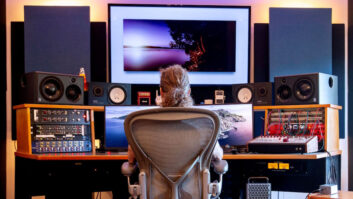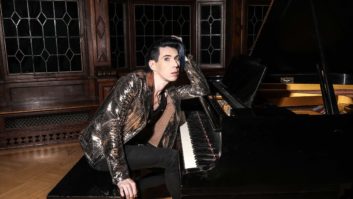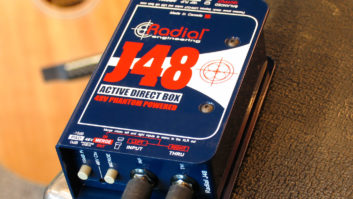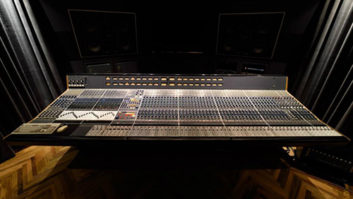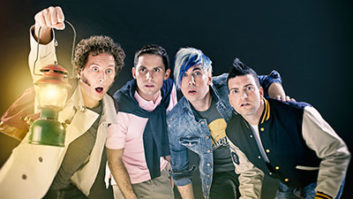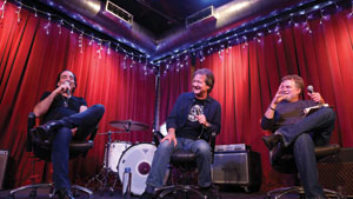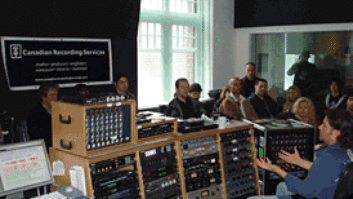Bryan Adams really pisses me off! That’s because he’s usually right. He was right when he said he could get Tina Turner to sing a duet with him on “It’s only Love” and it would be a hit. He was also right when he said “Everything I Do” would be a big hit.
When he put an SSL in the basement of his house and told me we were going to record his album Into the Fire in his living and dining rooms, I said he was nuts, that there would be too many problems. He said I was wrong. He was right. When he said he was going to build a big, beautiful commercial recording studio complex in Vancouver that would be one of the best such facilities on the face of the planet, I told him that this time he’d really lost his mind. once again, he was right.
Although I do think he’s crazy for taking on such a project.
Warehouse Studios (www.warehousestudio.com) is a major recording facility, in every sense of the phrase. It could be one of the last ever to be built. Bryan took a very courageous step when he committed what must have been a large portion of his hard-earned (and believe me, this guy works hard) cash to build a place like this. upon entering the facility for the first time, I knew I was in for an unusual treat when I encountered the open courtyard, complete with parking lot and putting green, where I expected to see the interior of an old warehouse. Taking a right into the main building, and after being graciously welcomed by the receptionist, I slowly became aware of Bryan’s massive antique mic collection in an impressive glass display case behind the reception desk. I was starting to think to myself, “This is more than just a recording studio, this is a recording palace!”
Touring the place, one is impressed by the lack of small rooms and tight hallways we studio moles have grown accustomed to. The lounges are large and bright, as are the control rooms and the one main recording room. No claustrophobia possible here. The stairways are open steel structures that add to the “warehouse” feel, but in a very Architectural Digest sort of way. As the place was being built, we kicked around the idea of me interviewing him once it was in operation. Now, I’ve had the pleasure of mixing Bryan’s most recent two albums, unplugged and on a Day Like Today in Studio 2 at The Warehouse on the SSL 9080 J Series. Each was a tremendous experience, on a level with working at my other two favorite studios, Peter Gabriel’s Real World and, of course, my own Mix This!
So, I interviewed Bryan after those albums were complete, and here’s what Bryan and I think about Warehouse Studios, among other things.
So what sort of mental illness were you suffering when you decided to build a large, commercial recording studio? In other words, why did you do it? Are you nuts?
During the course of the ten years or so it took to build The Warehouse, I asked myself that question quite a few times, but ultimately it was not mental illness, it was passion (which in itself is a sort of mental illness) that drove me out of my home studio into this venture. I haven’t looked back, so I guess it was right to be passionate!
Warehouse Studios is in the quaint, partially restored “Gastown” section of Vancouver. What influenced your decision to put it there? Did it have anything to do with the nearby strip clubs?
Ha! Well, as a client of our studio you know perfectly well. of course! I love the colorful ambience downtown. I always leaned toward having a studio in an eccentric neighborhood. I suppose it reminds me a little of New York when we recorded at Power Station together years ago. Remember how rough that area was? New York City was different then. A studio location is very important, and this one is downtown and that suits me, especially when I drop into Vancouver, because the hotel is so close I can ride my bicycle to work, which I love.
Did you consider proximity to local hotels and restaurants?
My main consideration was a cool building in a potentially cool area. When I bought the place, it was a burnt-out shell with vagrants living in it for shelter. Horrible. But I saw the potential instantly. Since then, the area has sprouted all kinds of restaurants and mad cafes, so we couldn’t be happier with the choice. I do wish the city didn’t tax us so much.
Can you tell me anything about the building it’s in? It’s quite old, isn’t it?
Yeah, it’s really old considering Vancouver’s history. originally, it was an old Klondike Supply building that used to sell goods to gold prospectors that came looking for their fortunes in the rivers of Canada. I didn’t realize when I bought it (nor did the city) that it is the oldest brick building in the city-circa 1886. Most other buildings were destroyed by the fire of the same year because they were wood-frame construction.
Anyone interesting recording there lately?
Yes. AC/DC, Metallica, the Tragically Hip, to name a few.
While we were mixing your album last year, your amazing cook, Manu, was preparing our meals in a nicely appointed kitchen/dining room on the second floor. Is the kitchen available to your clients?
Of course! There are separate kitchens in each studio. I don’t like to go out for meals when I’m recording; it takes too much time. So we made kitchens a prerequisite for each room.
Do they have to supply their own cook?
Well, people’s tastes vary so much that it’s better to cater to each client on an individual basis. our studio manager can arrange to bring someone in to cook. If she likes you, she might even do it herself…on second thought, no, she won’t!
As we both know, a good maintenance staff is extremely important in a large, busy studio like The Warehouse. Ron Vermeulen and Chris Potter are both incredibly talented at keeping the place running smoothly, and, of course, Ron is responsible for a great deal of the studio’s design. Where did you find these guys, and, knowing your personality, how do you keep them working for you?
With my charm, of course. [Smiles.] How else would I keep you from coming back, Bob? Seriously, Ron and I go back 25 years, when he was a tape op and I was singing in bar bands trying to make demos. When it came time to build a studio in my house, Ron helped me. [The album Into the Fire was recorded there.] So, as the studio grew, so did the dream of doing it properly. Both Ron and Chris have been invaluable, and whenever there was a dream, we would build it: mobile studio, portable Pro Tools racks-you name it, we did it, and it always worked.
Studio Two, The Mix RoomFor your mix room, which I love by the way, you chose an SSL 9080 J Series desk. Why?
I wondered if you’d ask me that. It seemed like the right way to go. SSL had been very good to me, and I always had trusted their products. I had no reason to believe their latest desk would be anything less than brilliant.
What do you like about it?
It sounds amazing. I’ve done three albums on it, and all of them sound great. I know you had some trouble getting around the software in the beginning, but they have sorted that out.
What don’t you like about it?
It kicks off an amazing amount of heat. We had to reconfigure our air-con unit for the mix room once that thing got going.
I noticed that you have large windows in the mix room that let in a lot of sunlight. Was that an important part of the design?
Integral. There was no way I wanted to work in a shoebox again. Daylight and a view onto the street are perfect in the recording studio, especially with the urban vibe where we are. It’s colorful out there. Plus, I learned from my home studio. It had a fantastic view over the garden and the bay. I wanted to peer out at something when I was working.
There are no large control room monitors in the mix room. Was that a decision you made, or have you and Ron just not gotten around to it?
After watching you work for 20 years, and never listening to loudspeakers unless we were recording, I thought, “What the heck? If it’s good enough for Bob…” We have portable large monitors that go in there if someone needs them, but nobody has asked. our new mix room will have enormous speakers, just like Studio one.
Is either of the rooms set up for doing 5.1-channel surround mixing?
We mixed my MTV unplugged show there, and Metallica mixed their live 5.1 DVD there. Now both mix rooms are set up for it. Love it.
Ron has done an incredible job of creating a fairly neutral but pleasing acoustic environment in the mix room, while keeping the original internal aesthetic of the building. Was this something you were adamant about, and how difficult was it to accomplish?
The natural space is so cool, none of us wanted to dick around with it. It’s a bit like a New York City loft space, so we worked within the parameters of what we had. Acoustically, the rooms needed tweaking, and we set about doing that once all the gear and furniture was in.
I see you have an old uREI Filter Set. You don’t see many of those nowadays. What’s that all about?
Certain clients, Bob, are intent on “notch filters.” There are some clients that are so intent on using them that we have two, just in case you want to double-filter the same frequency. You know what I’m on about? [This comes from an old joke when Bob was working with me in my home studio. He actually asked me if I had a “notch filter,” which of course I didn’t. I went out and bought two for the next session. I don’t think we ever used them, but we still laugh about it today.]
Studio one, The Recording RoomYou’ve got a magnificent old Neve 8078 in the control room. Can you give me a brief history of it?
It originally came from Air Studios in London. There were three desks built for Air, two of which they sold for some weird reason. one still exists at Air, and the other went to Montserrat and then later to A&M, and this is the third one and the largest, with 58 inputs. They were designed by Rupert Neve, Geoff Emerick and George Martin to the best of my knowledge. I first recorded on this exact desk in Atlantic Studios in New York when I was working with Joe Cocker on his album at the time. Later, I had heard that Atlantic went under and the desk had been sold to a company called QSound. They had intended to put together a studio, but at the last minute, they changed their minds. So, QSound gave me a day to decide if I wanted it. So, I bought it, and it sat in my warehouse for ages while Ron cleaned it up and waited for the studio to be built. We’ve never regretted that purchase. Man, what a fantastic desk; it sounds unreal. Rupert Neve actually signed a plate for us lately, which is mounted on the right corner.
I saw some very slick and unusual modifications on the desk. You seem to have really let Ron go to town in his usual fanatical way. Can you tell me about the major mods?
Ron would be better at explaining the technical than I, but in musician speak: We tried to make the desk as compatible with SSL engineers as possible. To do this, we put an SSL compressor in the desk, just like ordinary SSLs, and we also have several “Sneve” modules that Ron designed placed at the far end. A “Sneve” is an SSL module dressed up and fitted to look like a Neve module. It’s useful if you are an engineer and you want to use the SSL sound for something.
You’ve installed some pretty impressive looking and sounding control room monitors in this room. Where did they come from?
Ron designed them with my old touring sound company, Jason Sound. They are, without a doubt, the best large speakers I have ever heard in a control room. They crank!
I mixed your last album, on a Day Like Today, the basic tracks of which were recorded in there by Randy Staub, and produced by you and Bob Rock. The tracks sounded incredible! Can you share any insight into the design of the recording room itself?
Thanks. I think Randy and Bob did a great job, too. As far as the room is concerned, it was delicate construction taking out the third floor of the building to allow us maximum ceiling height (25 feet). other than that, we put in various angles on the isolation booths and retractable curtains and blinds, but left the room to be the room. It sounded fab.
You have some pretty serious windows in there as well. Is that ever a problem if you get your Marilyn Manson or Trent Reznor types in there who may, presumably, hate sunlight?
They haven’t come by lately, but we have retractable blinds. our place can look like a tomb. If that’s what you’re looking for…
The Pro Tools RoomAre you noticing an increasing number of artists and producers using Pro Tools for record projects these days?
Without a doubt. Compared to the old days when everyone edited on multitracks with razor blades, things have come leaps and bounds. It’s probably the best tool that has been invented to help create records. Aside from being able to edit and record, you can assemble your record, fix tunings, time things…endless. From my experience, it is a system that is totally dependent on the operator. I’ve seen people do great things with it, and I’ve seen some screwups!
Do you like to use it for your own projects?
Definitely. We have a whole setup of Macintosh computers to work on. Personally, I have created whole songs just by looping a groove or re-editing a section and turning it into a chorus when it was a b-section! used as a tool, it’s become invaluable.
The last time I was at The Warehouse, you only had one Apogee AD8000 8-channel analog-to-digital converter in the place, in the Pro Tools room. Have you remedied this appalling situation since then?
Yes, we went back to analog 11/44-inch with two Scully 11/44-inch machines locked up in sync! Seriously, we have been with Apogee since the beginning with the AD/DA-500s. We now have the AD8000 for 5.1 mixing and the latest PSX-100s in all rooms, for 24-bit, 96k mixing.
Is the Pro Tools room linked to the other rooms in some way, for transfers?
Yes. All of the rooms are interlocked to each other, including the Pro Tools room. It is sort of essential to do these days, especially when you have a group in using two rooms at a time, or to download a track to a Pro Tools operator and still continue to mix or record. It was a great plan.
other than it being very well-equipped with plenty of DSP Farms, lots of TDM plug-ins, a Yamaha 02R digital mixer, extra outboard gear and a very comfortable couch, is there anything else about it that we might be impressed by?
The tea is very nice…
You used to have an SSL 4072 G+ in the basement of your house, which I quite enjoyed mixing on. You moved it out last summer, but not to your new place. Why did you move it, where did it go, and will you be putting it in The Warehouse at any point?
It’s being reinstated as we speak into our second mix room, Studio Three. That means we will have our recording room [Studio one] and two mix rooms [Studio Two with an SSL J Series, and Studio 3 with the SSL G+]. The new room opens in June.
So what’s that room going to be like? Will it have a recording space?
Naturally. There are two recording rooms adjacent to the main studio. They will have a similar ambience to the other studios, only this mix room will have the SSL 4072 G+.
Do you have any other future plans for the place?
There is a lot of room to expand, and we may put in a film mixing studio down the road, but we’re taking it slowly. It’s enough to have a virtual soundstage and three studios working. Did I mention our golf course?
Do you still like to dress in women’s clothes…like in the old days?
Yes, of course, I’m so glad you asked.
The Mic CollectionHow did you get into collecting old mics?
Boredom on the road! I spent a few years scanning the flea markets of America for old mics for this mythical glass case. It was great fun, and the hunt was a challenge. Eventually, my road crew got into it, too, so I would get calls in advance of the gig telling me about a certain guy that knew someone that knew a guy that had a mic in his basement. I met some weird people searching for mics. They are a strange breed, mic collectors.
Where did you find them all?
Some of the best ones I found were in Europe. The Paris flea market was a bonanza. I could hardly believe my eyes. I found some extraordinary specimens there. I found a few good ones in Sweden too, but alas, I’ve been back since, and it’s not the same.
Do they all work?
I’m not sure. I collected them more for aesthetic reasons than practical ones, but I know all my vintage RCAs work; I’ve used them. There are a few older Neumanns that you can’t get the original valves for anymore, so they are ideal for the case.
Rumor has it that there are still many more that you haven’t found a place for yet. Can this be true?
Yes. I have two or three other boxes of mics that I have no room for. I may trade them to collectors at some point.
The DesignAs you know, I have my own little mix room in the basement of my home, where I am the only client. I love the freedom and control it gives me. I would think that a large, commercial studio like The Warehouse is a completely different animal. As a recording artist who spends most of his time in other parts of the world, do you enjoy owning it?
I love it. It’s part of my roots in Canada. Since I spend most of my time in England or on the road somewhere, I love coming back to Vancouver and spending time in this wonderful space. I wish I’d built an apartment in it for myself. I have been lucky in finding a good manager and, of course, Ron. Had he not been as into it, it would never have happened.
Did you enjoy building it?
After I had the right team together, it was a joy, but the usual pitfalls await anyone who wants to build something like this: primarily, architects and construction people who don’t know about acoustics. Poor Ron had to explain time and time again the principles of sound isolation!
If you had it to do over again, would you?
Yes, and probably for half the price! But you just don’t learn until you get in there and roll up your sleeves and do it.
Is there anything you would do differently?
Yes, but it’s all hindsight. I made errors in design, errors in choice when it came to contractors and outside designers, but I couldn’t have done it any other way. I was on the road for most of the construction phase, so there were bound to be a few surprises when I finally got back and saw what was going on.
You’ve worked in a lot of studios. Did any of them influence the design of The Warehouse? If so, which ones in particular, and how?
I wanted all kinds of things I’d seen. For example: isolation booths from Power Station, a Neve recording room like Air Studios in oxford Street, a fantastic collection of vintage and modern equipment like A&M, and huge spaces to work in like the Sony film stage in L.A. I think we have a great balance of all of the above.
You and Ron must have worked with an architect on the design of the place. Who was he or she, and how did you decide on who to use?
We used a local firm of architects, namely David Simpson, to get us around the seismic curves and to guide us through the city, and Ron did the sound design completely, and I laid out the space the way I wanted it.
Do you have any live echo chambers?
-We are intending on building two in the basement, we just have to get the mic collection out of there.
